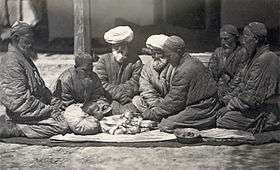Khitan (circumcision)
| Part of a series on |
| Islam |
|---|
 |
|
Khitan (Arabic: ختان) or Khatna (Arabic: ختنة) is the term for male circumcision[1][2] carried out as an Islamic rite by Muslims. Male circumcision is widespread in Islam and accepted as established practice by all Islamic schools of jurisprudence.[3] It is considered a sign of belonging to the wider Islamic community.[4]
Islamic male circumcision is analogous but not identical to Jewish circumcision. Islam is currently the largest single religious group in which the practice is widespread,[4] although circumcision is not mentioned in the Qur'an itself but is mentioned in a hadith and the sunnah. Whether or not it should be carried out after converting to Islam is debated among Islamic scholars.[5][6][7][8]
Religious sources

The Qur'an itself does not mention circumcision explicitly in any verse. In the time of the Islamic prophet Muhammad, circumcision of men was carried out by most pagan Arabian tribes and female circumcision by some, and male circumcision by Jews for religious reasons.[9] This has also been attested by Al-Jahiz,[10] as well as by Josephus.[11]
According to some traditions, Muhammad was born without a foreskin (aposthetic), while others maintain that his grandfather Abd-al-Muttalib circumcised him when he was seven days old.[12][13] Many of his early disciples were circumcised to symbolize their inclusion within the emerging Islamic community.[14] Some accounts report that Heraclius, Emperor of Byzantium, had referred to Muhammad as the "leader of the circumcised people".[15]
Some hadith mentions circumcision in a list of practices known as fitra (acts considered to be of a refined person). Abu Hurayra, a companion of Muhammad, was quoted saying, "Five things are fitra: circumcision, shaving pubic hair with a razor, trimming the mustache, paring one's nails and plucking the hair from one's armpits" (reported in the hadiths of Sahih al-Bukhari and Sahih Muslim). So, despite its absence from the Qur'an, it has been a religious custom from the beginning of Islam. However, there are other hadiths which do not name circumcision as part of the characteristics of fitra[16] and yet another hadith which names ten characteristics, again without naming circumcision; in Sahih Muslim, Aisha is quoted "The Messenger of Allah (may peace be upon him) said: Ten are the acts according to fitra: clipping the mustache, letting the beard grow, using toothpicks, snuffing water in the nose, cutting the nails, washing the finger joints, plucking the hair under the armpits, shaving pubic hair and cleaning one's private parts with water. The narrator said: I have forgotten the tenth, but it may have been rinsing the mouth."[17] Hence, the different hadiths do not agree on whether circumcision is part of fitra or not.
Muhammad's wife Aisha supposedly quotes Muhammad as saying that "ablution becomes necessary if the two circumcised members touch".[18][19] Furthermore, Muhammad is reported to have once advised a female circumciser not to cut off the entire clitoris during female circumcision.[20]
According to some hadith, Muhammad supposedly circumcised his grandsons, Hasan and Husayn, on the seventh day after their birth.[21] Sahih al-Bukhari and Muslim also quote from Muhammad that Prophet Abraham performed his own circumcision at the age of eighty.[22] It is also reported by Abu Dawud and Ahmad Ibn Hanbal that Muhammad stated that circumcision was a "law for men and a preservation of honor for women".[23]
Circumcision was introduced to many lands for the first time through Islam itself following the Muslim conquests under the Rashidun, who were the companions and contemporaries of Muhammad. An example are the Persians who did not practice circumcision before the advent of Islam.[24] Post-Islamic converts such as Afshin were found guilty in trials of remaining uncircumcised;[25] this further indicates that the practice was deemed compulsory by the early Muslims.
Sunni Islam
Amongst Ulema (Muslim legal scholars), there are differing opinions about the compulsion of circumcision in Sharia (Islamic law). Imams Abū Ḥanīfa, founder of the Hanafi school of Fiqh (Islamic jurisprudence), and Malik ibn Anas, maintain that circumcision is a Sunnah Mu'akkadah—not obligatory but highly recommended. The Shafi‘i and Hanbali schools see it as binding on all Muslims.[26]
Shia Islam
Most Shia traditions regard the practice as obligatory. They rely on sayings that come from classical Shia authors.[27] In one narration Muhammad was asked if an uncircumcised man could go to pilgrimage. He answered "not as long as he is not circumcised". They quote Ali as saying: "If a man becomes Muslim, he must submit to circumcision even if he is 80 years old."[28] Another narration from Al-Sadiq says: "Circumcise your sons when they are seven days old as it is cleaner (athar) and the flesh grows faster and because the earth hates the urine of the uncircumcised."[29] It is also believed that the urine of the uncircumcised is impure, while if one prays with unclean genitals their prayer may not be considered as acceptable, even of those who have been circumcised, meaning that it may have to be repeated again at a time when the believer has purified themselves and removed the impurity. Another hadith of Muhammad states: "the earth cries out to God in anguish because of the urine of the uncircumcised", and that "the earth becomes defiled from the urine of the uncircumcised for forty days".[30]
Quranists
Most Quranists claim circumcision is haram, arguing that Quran 4:119 forbids altering one's body, and 95:4 says man was created perfectly.[31][32][33]
Time for circumcision

Islamic sources do not fix a particular time for circumcision. It depends on family, region and country. A majority of Ulema however take the view that parents should get their child circumcised before the age of ten.[34] The preferred age is usually seven although some Muslims are circumcised as early as on the seventh day after birth and as late as at the commencement of puberty.[4]
Procedure
Whereas Jewish circumcision is closely bound by ritual timing and tradition, in Islam there is no fixed age for circumcision. The age when boys get circumcised, and the procedures used, tend to change across cultures, families, and time. In some Muslim-majority countries, circumcision is performed on Muslim boys after they have learned to recite the whole Qur'an from start to finish.[4] In Malaysia and other regions, the boy usually undergoes the operation between the ages of ten and twelve, and is thus a puberty rite, serving to introduce him into the new status of an adult.[35] The procedure is sometimes semi-public, accompanied with music, special foods, and much festivity.[36]
There is no equivalent of a Jewish mohel in Islam. Circumcisions are usually carried out in a clinic or hospital. The circumciser is not required to be a Muslim.[4] The position of the scar is usually neither fully "low" nor fully "high", and the skin left is rather loose. However, due to a relatively secular approach to circumcision in the Muslim world, the "styles" of the Islamic circumcision vary on every individual, and change in the light of new medical knowledge.[36]
Earlier, instead of being carried out in hospitals, they would be carried out in local clinics and terraces. The circumciser would generally scream "dekh kabootar", translating into "look at the pigeons" in Urdu, to distract the patient and then circumcise the individual.
Celebrations
In Indonesia, after a child is circumcised, there is a feast called Perayaan Sunatan, but some ulemas in Indonesia say this is bid‘ah whereas most of them say it is not. In Turkey also widely celebrated and called "Sunnet Toreni" "Sunnet mevludu".
Female genital mutilation
Khafḍ, or k̲h̲ifāḍ, refers to female genital mutilation (FGM).[3][37][38] FGM is sometimes referred to as khitan.[lower-alpha 1][40][3] In many communities, khafd is a rite of passage and refers to excision of the female genital organs.[41] Over 200 million women in Africa, the Middle East and Southeast Asia are thought to be living with FGM.[42]
See also
Notes
- ↑ Asmani and Abdi (USAID, 2008): "Proponents of FGM/C have translated the Arabic word khitaan, which appears in several religious texts, to refer to both male circumcision and FGM/C. In reality, however, the word only describes male circumcision; FGM/C is actually called khifaadh. However, whenever khitaan appears in a religious text it is used by the proponents to justify an Islamic basis for FGM/C."[39]
References
- ↑ Ibn Manẓūr, Muḥammad ibn Mukarram (1311). Lisan Al-Arab. Qumm, Iran. p. 1102. ISBN 9953131953.
- ↑ Lane, Edward William (1863). Arabic-English Lexicon. London: Willams & Norgate. p. 703. ISBN 8120601076.
- 1 2 3 khitān Encyclopædia Britannica (2009)
- 1 2 3 4 5 "Circumcision of boys". Religion & ethics—Islam. BBC. 2006-03-24. Retrieved 2008-07-29.
- ↑ "Male circumcision - the Islamic View". Converting to Islam. Retrieved 2013-02-04.
- ↑ "Is Circumcision obligatory after conversion?". Islamicinvitationcentre.com. Archived from the original on 2010-12-27. Retrieved 2012-05-20.
- ↑ "Considering Converting: Is it necessary to be circumcised?". Qa.sunnipath.com. 2005-07-03. Archived from the original on 2012-07-16. Retrieved 2012-05-20.
- ↑ "Circumcision for Converts". Qa.sunnipath.com. 2007-03-21. Archived from the original on 2012-07-16. Retrieved 2012-05-20.
- ↑ W. La Barre, The Ghost Dance, London, 1972
- ↑ Volume II of al-Hayawan by Jahiz, ed. A. M. Harun, 7 vols., Cairo, 1938
- ↑ The Works of Flavius Josephus, translated by W. Whiston, 2 vols., London, 1858
- ↑ "Religions – Islam: Circumcision of boys". BBC. 2009-08-13. Retrieved 2012-02-26.
- ↑ Al-Halabi, Ali Ibn-Burhan-al-Din. Alsirah al-halabiyyah. Vol.1 Beirut: Al-maktabah al-islamiyyah. (n.d.): 54–55
- ↑ source?
- ↑ Sahih Bukhari, vol. 1, book 1, no. 6
- ↑ "Hadith – Book of Dress – Sahih al-Bukhari – Sayings and Teachings of Prophet Muhammad (صلى الله عليه و سلم)". sunnah.com.
- ↑ "Hadith – The Book of Purification – Sahih Muslim – Sayings and Teachings of Prophet Muhammad (صلى الله عليه و سلم)". sunnah.com.
- ↑ Malik ibn Anas, Ketab al-mowatta, Volume I, pages 45-47, traditions 70-75. ed. M.F. Abd-al-Baqi, Cairo
- ↑ Ibn Majah, Kitab Sunan, ed. M. F. Abd-al-Baqi, Cairo, 1972, Page 199 Volume I
- ↑ Page 28 of Volume VII of al-Hayawan by Jahiz, ed. A. M. Harun, 7 vols., Cairo, 1938
- ↑ Al-Amili, Muhammad Ibn Hasan Al-Hur. Wasa'il al-shi'ah ila tahsil masa'il al-shariah. Vol 15. Tehran, Al-Maktabah al-Islamiyyah, 1982
- ↑ Sahih Bukhari Hadith No. 575, and Muslim's anthology of authentic hadith, IV, item 2370.
- ↑ Ahmad Ibn Hanbal 5:75; Abu Dawud, Adab 167
- ↑ Encyclopædia Iranica, Circumcision
- ↑ Page 766 of the Volume II of Al-Basaer wa al-Dhakha'ir, Abu Hayyan Tawhidi, Kaylānī, Damascus, 1964
- ↑ "Medical Ethics of Male Circumcision". Web.archive.org. 2010-05-30. Archived from the original on 2010-05-30. Retrieved 2012-05-20.
- ↑ Book 90 of Hilyat ul-muttaqeen
- ↑ Al-Kalini, Abu-Ja'afar Muhammad Ibn-Yaqub. Al-furu'min al-kafi. Vol. 6 Tehran: Dar al-kutub al-islamiyyah. 1981:35
- ↑ Al-Kalini, Abu-Ja'afar Muhammad Ibn-Yaqub. Al-furu'min al-kafi. Vol. 6 Tehran: Dar al-kutub al-islamiyyah. 1981:34
- ↑ DS Hellsten. Male and Female Circumcision: Medical, Legal and Ethical Considerations in Pediatric Practice. Page 147
- ↑ "Circumcision - Does the Quran Approve it? - Genital Mutilation | ختان | Khitan | Islam | Sunnah | Hadith | Khatna | Musolmani | Sunat | Sirkumsisi | Khatan | Tuli | Tule | Pagtutuli | Sunatan | Sünnet | Urkwtha | Tahara | Touhur | طهارة | طهور". QuranicPath. Retrieved 2012-02-26.
- ↑ "Revisionist Muslim « For All Monotheists". Allmonotheists.com. Retrieved 2012-02-26.
- ↑ Male and female circumcision, medical, legal, and ethical considerations George C. Denniston, Frederick Mansfield Hodges
- ↑ "Circumcision". Islamicvoice.com. 2000-03-28. Retrieved 2012-05-20.
- ↑ "Traditional Muslim Male Circumcision—Performed by Arabs, Turkish, Malaysian and Others of This Faith". Retrieved 2008-07-29.
- 1 2 "Style choices in relation to Religious Beliefs". Archived from the original on 2014-05-15.
- ↑ Aldeeb Abu-Sahlieh, Sami A., To Mutilate in the Name of Jehova or Allah, Legitimization of Male and Female Circumcision, Middle East Research Associates, Paper No. 21, 1994; see page 6-18
- ↑ K̲h̲afḍ, Encyclopaedia of Islam, Second Edition. Edited by: P. Bearman, Th. Bianquis, C.E. Bosworth, E. van Donzel, W.P. Heinrichs. Brill Online, 2013
- ↑ Ibrahim Lethome Asmani, Maryam Sheikh Abdi, De-linking Female Genital Mutilation/Cutting from Islam, Washington: Frontiers in Reproductive Health, USAID, 2008, 3–5.
- ↑ E. J. Van Donze (1994), Islamic Desk Reference (Compiled from Encyclopedia of Islam), ISBN 9004097384, Brill (Netherlands), p. 69.
- ↑ Gerald R. Hawting (2006), The Development of Islamic Ritual, ISBN 978-0860787129, page 358-361
- ↑ "Female Genital Mutilation/Cutting: A Global Concern", New York: United Nations Children's Fund, February 2016.
External links
![]()